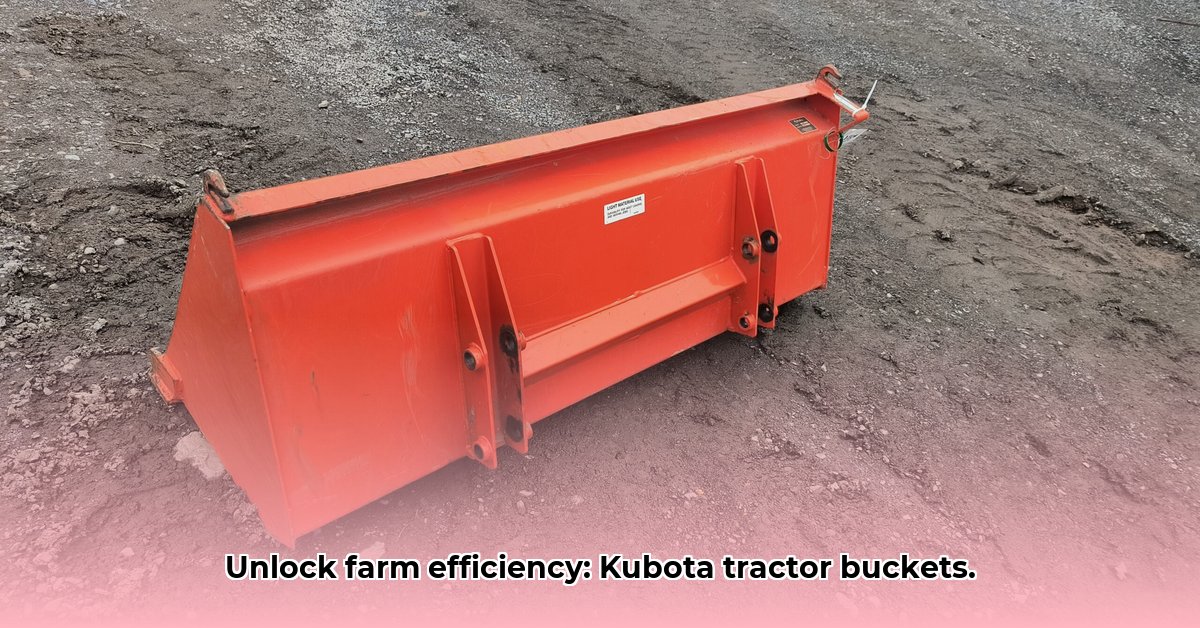
Understanding Kubota Tractor Buckets: More Than Just a Scoop
Choosing the right bucket for your Kubota tractor is crucial for maximizing efficiency and minimizing waste. A well-chosen bucket can significantly improve your farm's productivity and sustainability. This guide will explore the various types available, provide a step-by-step selection process, and offer crucial maintenance tips. Remember, the right bucket can significantly impact your bottom line and your farm's environmental footprint. Isn't optimized efficiency a key element of sustainable agriculture? For even more options, check out these Kubota grapple buckets.
Types of Kubota Buckets: Finding the Right Tool for the Job
Kubota offers a range of buckets, each designed for specific tasks. Selecting the appropriate type is critical for optimal performance and efficiency. Let's explore the common categories:
General-Purpose Buckets: These versatile buckets are suitable for a wide array of tasks, from moving dirt and gravel to handling lighter debris. They offer a good balance of versatility and durability for everyday farm chores. Are general-purpose buckets the right solution for your diverse needs?
Light-Material Buckets: Designed for handling lighter materials such as hay, grain, and mulch, these buckets often feature a wider opening for easier loading and unloading. Do you primarily work with lighter materials? A light-material bucket might be your best choice.
Heavy-Duty Buckets: Built to withstand demanding conditions, these robust buckets are ideal for moving rocks, clearing heavy debris, and tackling more strenuous tasks. Are you tackling tough jobs? A heavy-duty bucket offers the strength and durability you need.
Beyond these core types, specialized buckets exist for snow removal or pallet handling. Consult your Kubota dealer to discuss your specific requirements. They possess the expertise to guide you towards the most suitable option.
Choosing the Right Bucket: A Step-by-Step Guide
Selecting the correct bucket involves careful consideration of several key factors. This systematic approach will ensure that you choose the most effective tool for your specific farming needs:
Step 1: Assess Your Needs: What materials will you primarily handle? How much material do you typically move per load? Understanding your workflow is paramount.
Step 2: Determine Capacity: Bucket capacity is measured in cubic feet. Larger buckets handle more material per load, but might be too heavy for smaller tractors. It's a balance between efficiency and practicality.
Step 3: Evaluate Material Strength: The bucket's material strength directly impacts its longevity. Heavy-duty applications necessitate robust materials like reinforced steel.
Step 4: Verify Compatibility: Ensure the bucket is compatible with your Kubota tractor's quick-attach system. Incompatibility can lead to problems. Always double check.
Step 5: Consult Your Kubota Dealer: They offer valuable insights based on your specific needs and tractor model. Leverage their expertise.
This careful selection process maximizes efficiency and minimizes potential issues.
Mounting and Operating Your Kubota Bucket: Safety and Efficiency
Proper mounting and operation are crucial for safety and equipment longevity. Following these steps will ensure both:
Verify Compatibility: Before mounting, double-check compatibility with your Kubota tractor. Consult your owner's manual if needed.
Secure Attachment: Attach the bucket securely to your tractor's quick-attach system, adhering strictly to the manufacturer's instructions.
Engage Parking Brake: Always engage the parking brake before operating the bucket. This is a critical safety precaution.
Avoid Overloading: Never overload the bucket; overloading risks damage to both the bucket and tractor.
Controlled Movements: Operate the bucket with slow, controlled movements to avoid accidents and damage.
These practices are essential for safe and efficient operation.
Maintaining Your Kubota Bucket: Extending its Lifespan
Regular maintenance is key to maximizing the lifespan and performance of your Kubota bucket. Proactive maintenance minimizes downtime and replacement costs.
Regular Inspections: Inspect the bucket after each use for damage. Address minor issues promptly.
Thorough Cleaning: Clean the bucket thoroughly to prevent corrosion. A clean bucket lasts longer.
Proper Lubrication: Keep moving parts well-lubricated—this prevents premature wear.
Suitable Storage: Store the bucket in a dry place to prevent rust. Protection from the elements is essential.
Kubota Buckets and Sustainable Agriculture: A Synergistic Partnership
Efficient equipment use directly contributes to sustainable farming practices. A durable, well-maintained Kubota bucket reduces the need for frequent replacements, minimizing waste and conserving resources. Efficient operations often translate to lower fuel consumption, lowering your farm's environmental impact. Investing in quality equipment is an investment in sustainable agriculture. This approach is essential for long-term success and environmental responsibility.
Key Takeaways:
- Selecting the appropriate Kubota bucket minimizes fuel consumption and maximizes the equipment's lifespan which reduces waste.
- Efficient bucket use optimizes workload, reducing operational time and fuel usage.
- Proper maintenance prevents premature wear, prolonging the attachment's life and minimizing replacements.